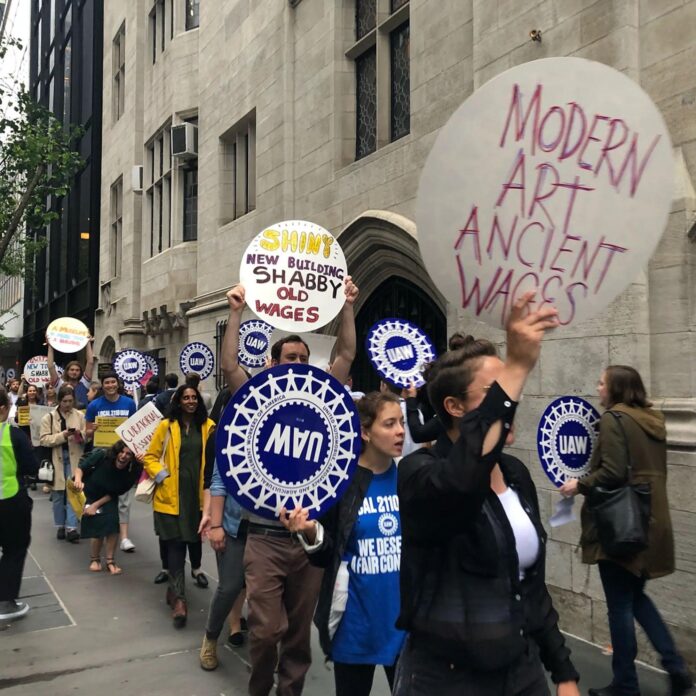Good news for cultural workers: as of 1 November last year, the Pay Transparency Law went into effect in New York City, requiring all businesses with four or more employees to publish the salary range for every job they post.
Hooray! The days of listings announcing “compensation commensurate with experience” are over, a welcome development because this opaque practice led folks to waste time applying for jobs they could not afford to take. More importantly, with no set salary range, you often need to negotiate and, according to the Harvard Business Review, men get better outcomes in wage negotiations—whether because of their own sense of privilege or the boss’s estimation of the employee’s worth. Likewise, according to a 2022 report from Pew Charitable Trusts, wage transparency leads to more equitable outcomes, albeit slightly worse for men.
In 2019, a group of museum workers took transparency into their own hands and launched a public spreadsheet in which people anonymously reported their salaries. By the time it closed, there were 3,326 entries. People were getting into the weeds, the nitty-gritty of employment. Suddenly, a salary transparency Google document became the must-read text of the day, a far cry from the theoretical art criticism that used to consume our attention.
Goal for reform
The art world is famously an unregulated system where financial arrangements are beyond public view, but institutional transparency is increasingly embraced as a goal for museum reform. Without doubt, bad labour practices in museums are nothing new. At the very first American Association of Museums conference in New York City in 1906, the Museum of Fine Arts (MFA) Boston outlined what museums should offer visitors, including oral interpretation by lecturers. They were referring to their innovation: unpaid museum guides they called “docents”. This model spread widely and stayed largely intact for 100 years, practically guaranteeing museum visitors would be greeted by a guide with the resources to work for free.
In recent years, museums’ unpaid docents have gradually been replaced with contract workers—often artist educators. It is a better model, but still precarious employment, as we saw when these educators were hit with massive layoffs during the early days of the Covid-19 pandemic. Over in the curatorial department, the path to professional success often started with an unpaid internship, leading to low-paying curatorial assistant jobs. Then, if you were lucky, you might ascend to a full curator position supported by the next crop of unpaid interns and underpaid curatorial assistants. It was a cycle of exploitation. Thankfully, the unpaid internships seem to be winding down and curatorial assistants are demanding more.
Folks are sick of the status quo, and they are not afraid to say so. What happened? We are living in the post-Great Recession period where young museum professionals have spent their first years in the workforce enduring stagnant or falling wages. This generation are starting their careers in cities where rent is unaffordable. Most are saddled with student debt. Happily, the workforce is becoming more diverse, especially the younger staff. At the same time, infuriatingly, Black borrowers have greater student debt.
This is the first generation of social media-native museum workers. They have ample opportunity to share their experiences, to voice their dissatisfaction on social media where algorithms amplify outrage (which in this case is justified). No surprise, then, that the past few years have seen demands for living wages in more humane and transparent work environments. Unionisation efforts and struggles for better contracts are sweeping across the cultural world, from the Brooklyn Museum to the Tacoma Art Museum, from the MFA Boston to the Philadelphia Museum of Art.
This year we organised a panel of museum directors to speak with the new cohort at the Center for Curatorial Leadership. In the past, this discussion had focused on different aspects of the museum director’s job, like capital projects, exhibitions and fundraising. This year we spent the whole time speaking about toxic work environments, transparency, unionisation and what new models of leadership might function better in the current work environment. It got us thinking—maybe the new avant-garde at museums is in the human resources department. Wage transparency in job listings is an important step and probably a welcome change for the thousands of workers who populated that Google document. Museums should embrace this change as they envision a more transparent future.
• Tom Finkelpearl is a writer and curator, former commissioner of New York City’s Department of Cultural Affairs, and former director of the Queens Museum. Pablo Helguera is a visual and performance artist living in New York. Finkelpearl and Helguera are working on a book about the challenges facing US art museums

























